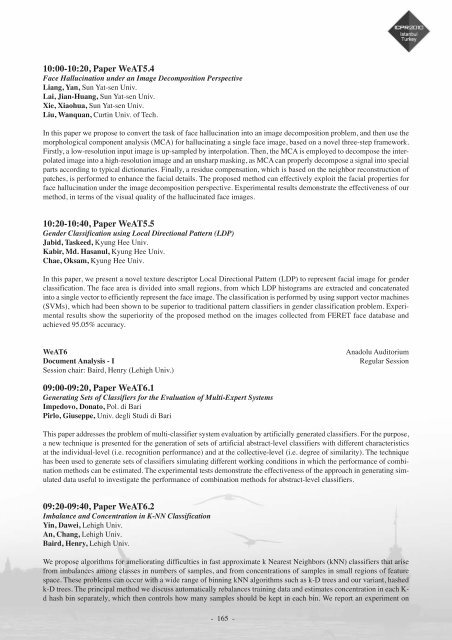Abstract book (pdf) - ICPR 2010
Abstract book (pdf) - ICPR 2010
Abstract book (pdf) - ICPR 2010
- TAGS
- abstract
- icpr
- icpr2010.org
Create successful ePaper yourself
Turn your PDF publications into a flip-book with our unique Google optimized e-Paper software.
10:00-10:20, Paper WeAT5.4<br />
Face Hallucination under an Image Decomposition Perspective<br />
Liang, Yan, Sun Yat-sen Univ.<br />
Lai, Jian-Huang, Sun Yat-sen Univ.<br />
Xie, Xiaohua, Sun Yat-sen Univ.<br />
Liu, Wanquan, Curtin Univ. of Tech.<br />
In this paper we propose to convert the task of face hallucination into an image decomposition problem, and then use the<br />
morphological component analysis (MCA) for hallucinating a single face image, based on a novel three-step framework.<br />
Firstly, a low-resolution input image is up-sampled by interpolation. Then, the MCA is employed to decompose the interpolated<br />
image into a high-resolution image and an unsharp masking, as MCA can properly decompose a signal into special<br />
parts according to typical dictionaries. Finally, a residue compensation, which is based on the neighbor reconstruction of<br />
patches, is performed to enhance the facial details. The proposed method can effectively exploit the facial properties for<br />
face hallucination under the image decomposition perspective. Experimental results demonstrate the effectiveness of our<br />
method, in terms of the visual quality of the hallucinated face images.<br />
10:20-10:40, Paper WeAT5.5<br />
Gender Classification using Local Directional Pattern (LDP)<br />
Jabid, Taskeed, Kyung Hee Univ.<br />
Kabir, Md. Hasanul, Kyung Hee Univ.<br />
Chae, Oksam, Kyung Hee Univ.<br />
In this paper, we present a novel texture descriptor Local Directional Pattern (LDP) to represent facial image for gender<br />
classification. The face area is divided into small regions, from which LDP histograms are extracted and concatenated<br />
into a single vector to efficiently represent the face image. The classification is performed by using support vector machines<br />
(SVMs), which had been shown to be superior to traditional pattern classifiers in gender classification problem. Experimental<br />
results show the superiority of the proposed method on the images collected from FERET face database and<br />
achieved 95.05% accuracy.<br />
WeAT6 Anadolu Auditorium<br />
Document Analysis - I Regular Session<br />
Session chair: Baird, Henry (Lehigh Univ.)<br />
09:00-09:20, Paper WeAT6.1<br />
Generating Sets of Classifiers for the Evaluation of Multi-Expert Systems<br />
Impedovo, Donato, Pol. di Bari<br />
Pirlo, Giuseppe, Univ. degli Studi di Bari<br />
This paper addresses the problem of multi-classifier system evaluation by artificially generated classifiers. For the purpose,<br />
a new technique is presented for the generation of sets of artificial abstract-level classifiers with different characteristics<br />
at the individual-level (i.e. recognition performance) and at the collective-level (i.e. degree of similarity). The technique<br />
has been used to generate sets of classifiers simulating different working conditions in which the performance of combination<br />
methods can be estimated. The experimental tests demonstrate the effectiveness of the approach in generating simulated<br />
data useful to investigate the performance of combination methods for abstract-level classifiers.<br />
09:20-09:40, Paper WeAT6.2<br />
Imbalance and Concentration in K-NN Classification<br />
Yin, Dawei, Lehigh Univ.<br />
An, Chang, Lehigh Univ.<br />
Baird, Henry, Lehigh Univ.<br />
We propose algorithms for ameliorating difficulties in fast approximate k Nearest Neighbors (kNN) classifiers that arise<br />
from imbalances among classes in numbers of samples, and from concentrations of samples in small regions of feature<br />
space. These problems can occur with a wide range of binning kNN algorithms such as k-D trees and our variant, hashed<br />
k-D trees. The principal method we discuss automatically rebalances training data and estimates concentration in each Kd<br />
hash bin separately, which then controls how many samples should be kept in each bin. We report an experiment on<br />
- 165 -



